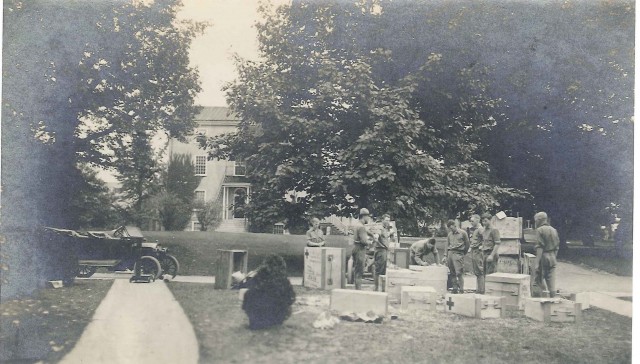Origin of the American Friends Service Committee
—Written by Jack Sutters, former AFSC archivist

Image: AFSC
The events that gave birth to the American Friends Service Committee began with a meeting of fourteen Friends on the last day of April 1917 in Philadelphia, Pennsylvania. At the beginning of that month, the United States declared war on Germany and its allies, and Friends foresaw an approaching crisis for young Quakers, who would be subject to the draft. In this initial meeting,* they discussed what constructive work might be done in the battle zone of northern France and how those conscientiously opposed to war might carry out alternative service there.
Supporting conscientious objectors
The immediate problem was how to deal with the United States’ chaotic system for dealing with religious objectors. While members of religious bodies that did not believe in war were supposed to be exempt from the draft, the law was interpreted in a wide variety of ways. Confusion reigned. Many Quakers, Mennonites, and Brethren, as well as others who opposed war on the basis of conscience, were ordered to military camps. Many others who were unaware of the significance of donning a uniform did so, only to find this was interpreted as willingness to serve in the military. Threats and mistreatment occurred, particularly against those who were most determined to follow their conscience.

Image: AFSC
Early AFSC workers tried to identify these individuals, locate the camps at which they were stationed, visit them, and provide spiritual and moral support. Some government agencies were helpful. In areas where the three historic peace churches (named above) had significant membership, many draft boards cooperated with the Service Committee and released conscientious objectors to it for alternative service work. At Haverford College, for example, one hundred young men gathered and trained for work to be carried out in cooperation with their British counterparts in the war zone in France.
Material relief for those displaced by war
In addition to providing alternative service opportunities for conscientious objectors, the AFSC collected relief material for those who were displaced from their homes in France. Early AFSC brochures and records indicate people could support these efforts by growing fruits and vegetables, canning them, and sending them to the AFSC warehouse in Philadelphia for shipment to France. People also sewed and knitted garments, using patterns from the AFSC. These new items, along with used clothing were collected in the warehouse in Philadelphia and readied for shipment abroad.
Determining a name and location
Less than a month after the first committee meeting, the organization’s original name, the Friends National Service Committee, was changed to the American Friends Service Committee. Vincent Nicholson, a Midwestern Quaker, was appointed executive secretary. AFSC’s first office was at the Friends Institute, 20 South 12th Street, an address that became familiar to large numbers of people. In subsequent years, letters simply addressed to “Quakers, Philadelphia, Pa.,” were automatically delivered to this location by the post office.
In 1975 the AFSC moved its national headquarters to Friends Center, a complex of buildings that houses many Quaker offices, in addition to the AFSC. Coincidentally, the Whittier Building, where those fourteen concerned Friends first met 84 years ago, is part of the property of Friends Center. The idea born on that spot in an age of war has grown into an international organization that addresses the underlying causes of violence as part of its continuing commitment to peacemaking.
And the old material aids warehouse? It is in the same place: in the basement of the Race Street Meetinghouse, which is attached to the newer buildings of Friends Center. Material aids of all types still pass through the warehouse on their way to people who need them in many parts of the world.

Image: AFSC
After World War I, Rufus Jones, who helped found the AFSC, wrote a book (A Service of Love in War Time) about the AFSC’s establishment and early work. About those who were unwilling to serve in the armed forces, he said, “They did not take their unique and difficult position because they were obstructionists. They took it because they were inwardly pledged to a way of life which, if extended through the world, would eliminate the seeds of war and would bring new and higher forces into operation within the fabric of society.”
*This initial meeting of Friends was also significant because representatives from both Hicksite and Orthodox Quaker yearly meetings in Philadelphia attended in a spirit of cooperation, along with representatives of the Five Years Meeting of Friends. The first two groups had separated ninety years before after a bitter theological debate. Both used silence in their worship. The last named was a geographically wider association of yearly meetings who generally followed a programmed service with clergy officiating. The meeting was, therefore, an opportunity to bring together disparate Quaker groups to address the emergency all would face.
Source: Republished from the history section of the American Friends Service Committee according to the terms of Creative Commons (CC BY-NC-ND 2.0) http://afsc.org/story/origin-afsc. (Accessed November 12, 2015)

0 Replies to “American Friends Service Committee”
Comments for this site have been disabled. Please use our contact form for any research questions.